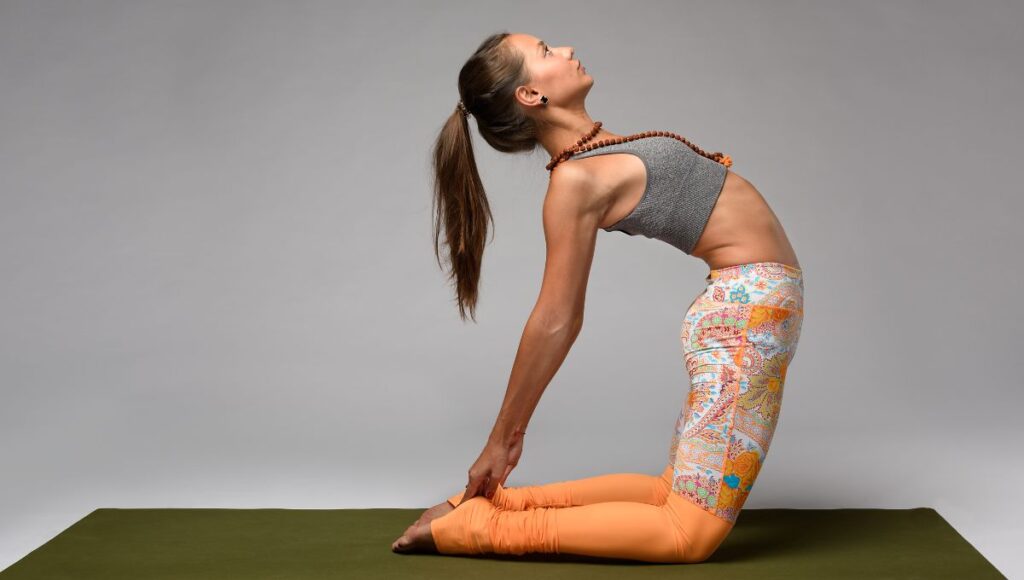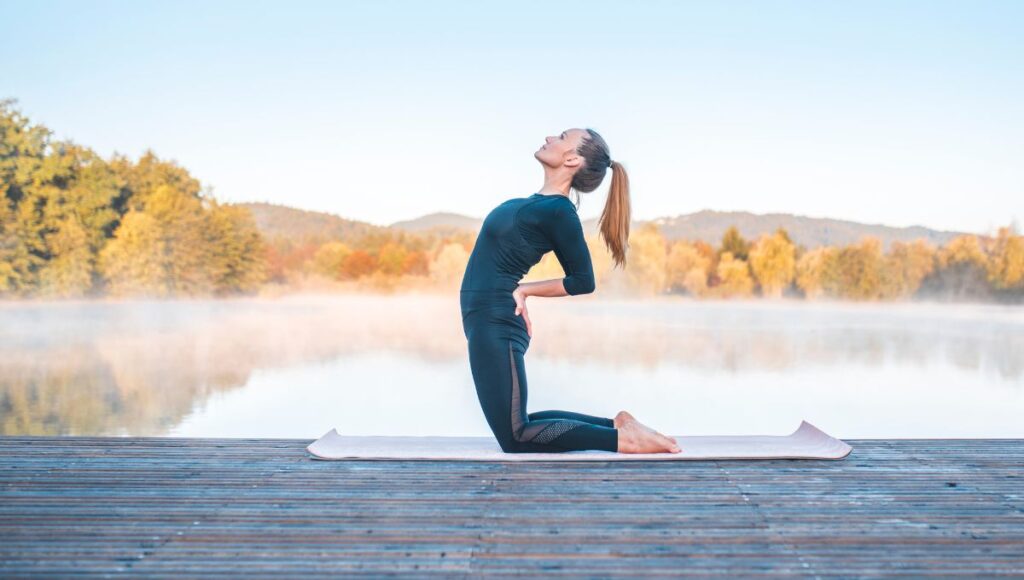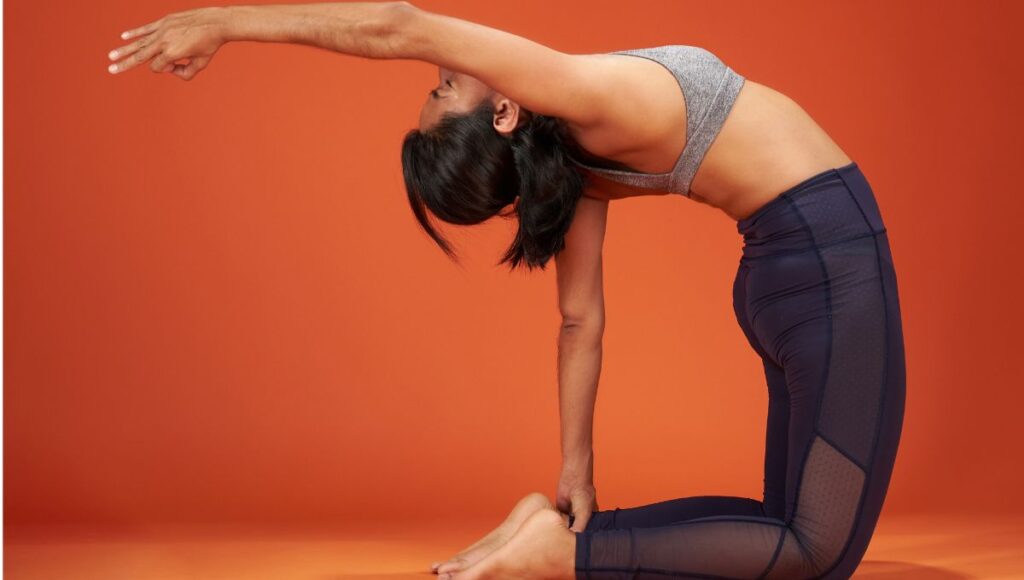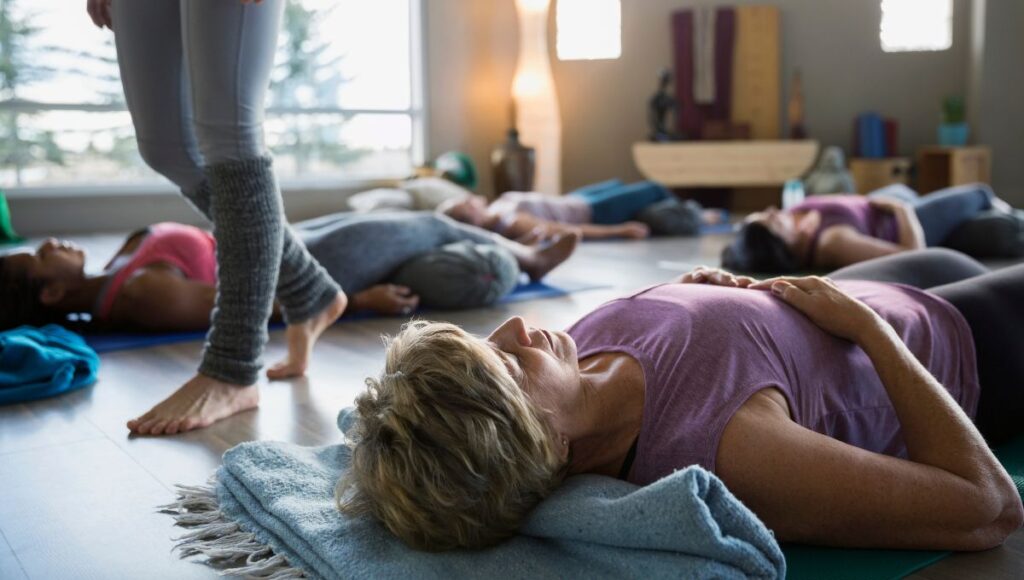
Camel Pose Yoga: How To, Tips & Common Mistakes
Camel pose, also known as Ustrasana in Sanskrit, is a popular yoga posture that offers a multitude of benefits for both the body and mind. This beautiful backbend opens up the heart center and stretches the entire front side of the body. It requires strength, flexibility, and a sense of surrender to fully experience its transformative power.
The act of exposing our hearts symbolizes vulnerability but also invites us to embrace courageously all that life presents us with.
Mentally and emotionally, it helps release stagnant energy from our core while inviting feelings of compassion and love toward ourselves and others.
Here’s what we’ll look at:
- What Muscles Are Involved?
- Step-By-Step Instructions
- Variations
- Benefits
- Common Mistakes
- Beginner’s Tips
What Muscles Are Involved?
Ustrasana is a beautiful and invigorating yoga posture that opens up the front side of the body while simultaneously stretching and strengthening various muscle – it resembles the graceful arch of a camel’s hump, hence its name.
Camel pose primarily targets the front body muscles such as the quadriceps, psoas major, rectus abdominis (abs), obliques, intercostal muscles between the ribs, and even stretches the throat region. By opening up these areas of the body through deep stretching and controlled breathing in this pose, you can experience improved digestion and increased flexibility in the hips and spine.

First up, let’s talk about the muscles in your back. When you arch your spine backward in camel pose, you activate a whole host of muscles.
The main ones being the erector spinae, which run along either side of your spine and help keep it stable. These muscles work hard to maintain the integrity of your back as you lean back into the pose.
Additionally, your latissimus dorsi also come into play here. These broad back muscles extend from your upper arm bone all the way down to your lower spine.
They help add strength and stability to your backbend while providing support to keep you balanced. Moving on to our core muscles—those powerhouse stabilizers that we can’t forget about!
Camel pose is fantastic for engaging both our deep core muscles and our superficial ones. The rectus abdominis (aka “six-pack” abs) get activated as they work to keep you upright during this intense stretch.
Meanwhile, deeper abdominal muscles like the transverse abdominis kick into action as they stabilize and support your spine throughout the movement. Let’s not forget about those leg muscles that are helping us achieve a solid foundation in camel pose.
While it may seem like a primarily upper body-focused posture, our legs play an important role too! As you kneel on the mat with toes tucked under or flat on the floor (depending on variations), your quadriceps engage to support alignment and prevent strain on other parts of your body.
Additionally, hip flexors like the iliopsoas come into play when extending backward from the thighs and help maintain balance during this backbend. So, as you can see, camel pose is a full-body experience that doesn’t leave any muscle group behind.
From your back muscles to your core and all the way down to those leg muscles, each part of your body gets its chance to shine and strengthen. Embrace the challenge and let these muscles work together harmoniously as you gracefully explore the depths of camel pose yoga.
Step-By-Step Instructions
1. Start by kneeling on the floor with your knees hip-width apart.
Ensure that your shins and tops of your feet are pressing firmly into the ground.
2. Place your hands on the back of your pelvis with your fingers pointing downward.
Your thumbs should be resting on the sacrum while your fingertips are lightly touching the top of your glutes.
3. Inhale deeply, lengthening through your spine and lifting your chest upward.
Imagine a string pulling you up from the crown of your head.

4. As you exhale, gently begin to lean back, gradually bending backward at the hips.
Keep engaging your core muscles to support your lower back throughout this movement.
5. Reach one hand at a time to grasp onto each respective heel or calf muscle, depending on what feels comfortable for you.
If reaching for both heels simultaneously is challenging, it’s perfectly fine to keep one or both hands supporting you on the lower back.
6. Once you have established a solid grip, deepen the stretch by pushing gently against the soles of your feet or ankles while simultaneously lifting through the sternum and broadening across the chest.
7. Maintain steady breathing throughout this posture and try to relax any tension in your neck and jaw as you hold camel pose for 30-60 seconds.
8. To release from camel pose, slowly bring one hand at a time back to support on either side of the lower back while using an inhale breath to lift yourself upright into an upright kneeling position once again.
Remember that practicing yoga is all about listening to your body’s limitations and honoring them without pushing too far beyond what feels comfortable or safe for you in each moment.
Feel free to modify any aspect of this pose by using props such as blocks or bolsters if needed – just make sure that you’re always able to maintain proper alignment and avoid strain or injury.
As with any new posture, it’s recommended to practice under the guidance of a certified yoga instructor to ensure correct alignment and prevent any unnecessary risk. Take the time to explore and gradually deepen your camel pose, enjoying the benefits it brings.
Variations
When practicing camel pose, there are several variations you can explore to enhance the experience and cater to your individual needs. These variations can intensify the stretch, target specific muscle groups, or provide modifications for practitioners with different levels of flexibility.
Supported Camel Pose
One common variation is the supported camel pose.
This variation involves using props such as blocks or bolsters to provide support and stability as you deepen into the backbend.
To perform this variation, start by placing a block vertically between your feet.
As you reach back and place your hands on your heels, allow your torso to rest on the block instead of going all the way down to touch the floor.
This modification helps those with limited flexibility in their spine or tight quadriceps to still reap the benefits of camel pose while maintaining alignment.
Revolved Camel Pose
If you’re looking for an extra challenge and want to take camel pose up a notch, try incorporating a twist into it. Known as twisted or revolved camel pose, this variation not only opens up the chest but also targets your obliques and spinal muscles.

Begin in standard camel pose position with both hands reaching back towards your heels.
Instead of keeping both hands on one heel, take your left hand to your right heel while extending your right arm up towards the ceiling in a twist motion.
Hold this position for a few breaths before returning to center and repeating on the opposite side.
For practitioners who have been practicing camel pose for some time, lifting one leg off the ground while maintaining balance adds an extra element of difficulty and intensity.
One-Legged Camel Pose
Known as one-legged camel pose, this variation requires core strength and stability along with increased flexibility in both hips and quads.
Start in traditional camel pose position with both hands reaching back towards your heels; then lift one leg off the ground while keeping a strong foundation through your standing leg.
This variation not only challenges your balance but also further stretches your hip flexors and quadriceps.
By exploring these variations of camel pose, you can cater the practice to your specific needs and continue to evolve in your yoga journey.
As with any yoga pose, it’s essential to find the version that works best for you while respecting your body’s unique abilities and boundaries.
Benefits of Camel Pose Yoga
- Improved Posture: Camel Pose helps open up the chest and shoulders, which can lead to better posture by countering the effects of slouching and sitting for extended periods.
- Enhanced Flexibility: This pose stretches the front of the body, particularly the spine, abdomen, and hip flexors, promoting flexibility in these areas.
- Strengthened Back: By engaging the muscles of the lower back, Camel Pose can help strengthen and tone the back, reducing the risk of back pain and injury.
- Increased Lung Capacity: The deep backward bend in Camel Pose allows for expanded chest and lung capacity, aiding in better breathing and increased oxygen intake.
- Digestive Health: Ustrasana massages and stimulates the organs in the abdominal region, potentially improving digestion and alleviating issues like constipation.
- Stress Reduction: The practice of Camel Pose can be emotionally uplifting and provide relief from stress and anxiety by opening the heart center and releasing tension.
- Improved Circulation: The backward bend in this pose enhances blood flow to the brain, which may help improve mental clarity and energy levels.
- Enhanced Focus and Concentration: Regular practice of Camel Pose can improve mental focus and concentration by calming the mind and reducing distractions.
- Emotional Release: This deep backbend can release stored emotions in the heart area, providing a sense of emotional release and relief. The curvature of this asana creates space within ourselves physically while also encouraging emotional openness and vulnerability.

Common Mistakes
Straining Your Neck
One of the most common mistakes practitioners make when attempting camel pose is straining their neck and collapsing their upper body. It’s important to remember that camel pose is a backbend, not a neck stretch.
To prevent this mistake, start by focusing on engaging your core and lengthening your spine upward before beginning the backbend. As you lean back, maintain a gentle lift in your chest and draw your shoulder blades down your back.
This will ensure that the movement originates from your thoracic spine rather than placing unnecessary strain on your neck.
Overextending
Another common mistake is overextending the lower back and compressing the lumbar spine.
While it’s tempting to go deeper into the bend by pushing your hips forward, doing so can lead to discomfort or even injury. Instead, focus on maintaining a balanced engagement throughout the entire spinal column.
The key here is to initiate the movement from the lower ribs while keeping the pelvis stable and neutral. By actively engaging your core muscles, you’ll create a solid foundation for a safe and effective camel pose.
Rushing
Rushing into your deepest expression of the pose without proper warm-up or preparation is another frequent error many people make with camel pose.
This can increase the risk of strain or injury in vulnerable areas such as shoulders, lower back, or knees.
To avoid this mistake, take ample time to warm up your entire body before attempting camel pose. You can start with gentle stretches for the hips and shoulders, followed by some dynamic movements like cat-cow or sun salutations to awaken and mobilize the spine.
Gradually work towards deeper backbends through preparatory poses like cobra or bridge pose before progressing into camel pose itself.
Remember that every body is unique, so it’s crucial to listen attentively to what feels right for you.

Beginner’s Tips
1. Warm-up and Stretch Before Attempting Camel Pose:
Before diving into the depths of camel pose, it is crucial to properly warm up your body and stretch your muscles. A few minutes of gentle stretching can make a world of difference in preparing your body for this intense backbend.
Start with some simple neck rolls, shoulder stretches, and gentle twists to loosen up the upper body. Follow this up with some hip openers such as lunges or butterfly stretches to get your lower body ready.
2. Engage Your Core and Focus on Breath
As you begin practicing camel pose, it’s important to remember that core engagement is key.
Keep your abdominal muscles activated throughout the entire process to protect your lower back and maintain stability in the posture. Additionally, focus on controlled breathing during each stage of camel pose.
Take deep inhales through your nose, allowing the breath to expand into your ribcage and upper chest. Exhale fully through slightly parted lips, releasing any tension or discomfort you may feel.
3. Use Props for Support
Especially if you are a beginner or have limited flexibility in certain areas, utilizing props can greatly assist you in achieving a comfortable camel pose variation that suits your body’s needs.
Consider using yoga blocks positioned vertically alongside each foot as an extra support system during the backbend phase.
Alternatively, if reaching for your heels feels challenging at first, place a bolster or rolled-up yoga mat beneath them for added elevation and stability.
4. Listen to Your Body
One of the most important beginner tips when practicing camel pose is to always listen to your body cues and respect its limits without pushing too far too soon.
Remember that every individual’s anatomy differs; what feels accessible for one person might be quite challenging for another due to variations in flexibility and strength levels. If at any point during the posture you feel sharp pain or discomfort beyond mild stretching sensations, slowly release from the pose and take a moment to recalibrate.
Practice patience and consistency, gradually working towards greater depth and duration in camel pose over time.
Remember to be patient with yourself, as mastering this pose takes time and practice. Stay committed, listen to your body, and enjoy the transformative benefits that camel pose yoga has to offer.
Conclusion
Camel pose yoga is a powerful and transformative posture that not only enhances physical strength and flexibility but also taps into our emotional and spiritual well-being. By opening the heart space and expanding our chest, this pose allows us to release tension, cultivate self-acceptance, and invite a sense of vulnerability into our lives.
Through consistent practice, camel pose can help us develop resilience, confidence, and an unwavering belief in our own capabilities. Remember that practicing camel pose should always be approached with mindfulness and respect for your body’s limits.

